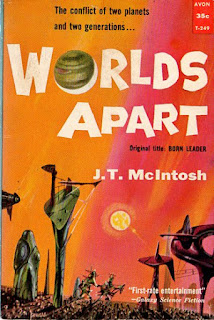Here's an Ace Double from the recently deceased Fred Saberhagen [I wrote this review first in 2007], backed with one from regular John Rackham. Saberhagen wrote one other Ace Double half, The Golden People (1964), while Rackham was a regular under that name and his real name, John T. Phillifent, contributing 16 total "halves". The Water of Thought is about 44,000 words long, and We, the Venusians is some 53,000 words.
 |
| (Covers by Jerry Podwil and Jack Gaughan) |
Fred Saberhagen was born on May 18, 1930, in Chicago (hence this reposting of the review), and died in 2007. After stints in the Air Force, at Motorola, and with the Encylopedia Britannica, he became a full-time writer in the mid-70s. He began publishing in 1961, and from very early in his career he was writing about the inimical machine intelligences called the Berserkers, which remain his most enduring contribution to SF. His post-apocalyptic fantasy-flavored novels beginning with the Empire of the East trilogy are also well regarded, and I quite enjoyed his singleton novel The Veils of Azlaroc. As ever, the Science Fiction Enyclopedia entry is very useful: here.
The Water of Thought is set on a world, Kappa, only tenuously colonized by humans, who live behind a forcefield. They have only limited, but generally benign, contact with the intelligent natives, called Kappans. The main character is a "planeteer", Boris Brazil, who is spending a brief vacation, in the company of a local girl named Brenda. He is called back to the colony for an emergency -- it seems another planeteer, Eddie Jones, has gone nuts and killed a Kappan and run off to the hinterlands.
So Boris, in the company of Brenda, heads to the interior to investigate. Their copter is sabotaged, and they are rounded up by Jones and his Kappan friends. They quickly learn that Jones believes that the humanlike Kappans are on the cusp of evolution to full sentience, and he hopes to guide them on the next step, with the help, perhaps, of "the water of thought", a druglike substance that has transformed his consciousness. Alas, it affects Boris differently -- makes him a slave to Jones's every command.
Boris and Brenda are taken to a Kappan village, eventually to be subjected to a brutal initiation ceremony. But Boris escapes, and begins to learn the true secrets behind things. The Kappans aren't the only sentients on the planet, for one thing. And the colonists aren't all so innocent, for another -- it seems the sometimes hallucinogenic properties of the "Water of Thought" have attracted the attention of interstellar druglords. The resolution involves a meeting with the "real" Kappans, a more primitive (supposedly) race ... complete with learning the (somewhat icky) true nature of the Water of Thought. Basically, it's not terrible work, but nothing very special either.
An expanded version of The Water of Thought was published in 1981, but I have not seen that.
John Rackham's real name was John T. Phillifent (1916-1976). He also began publishing in the early '50s, though much less prolifically. He ended up producing something north of 20 novels as well as a fair amount of shorter work, under both the Rackham and Phillifent names.
I've rather enjoyed some John Rackham Ace Doubles, so I approached We, the Venusians with some optimism. And the opening is at least mildly promising. Brilliant pianist Anthony Taylor is approached by an influential Venusian colonist. He wants to take him, and a couple of other musical artists, to Venus, apparently to raise the cultural level of the colony. There is a small colony on the planet, but very rich, because they raise a plant, with the unwilling help of the subhuman local "greenies", that confers immortality and health on people.
Anthony Taylor has a secret, however, He is a half-Greenie himself, and takes "anti-tan" pills to hide this fact. So too does the Aussie singer Martha Merril who is also recruited to travel to Venus. But she is in denial. (The weird thing about all this is that it is taboo to take those pills, apparently because they would allow black people to "pass".) So -- an interesting setup, as they head to Venus, with the obviousl plot being the liberation of the Greenies.
Which is pretty much what happens, only somehow much less interestingly than I had hoped. For one thing, Taylor and Merril seem not necessarily to be half-breeds, but perhaps full Greenies, who were adopted by human parents. And the Greenies communicate mystically by telepathy ... not one of my favorite plot devices. And the whole Greenie society is a letdown -- particularly the bit about how they abandon their defectives, who turn out to be the slaves used to harvest the immortality bean ... All in all, a mess of a novel. (I was intrigued to note that this is one of at least two Rackham novels featuring beautiful and perfectly humanoid alien women with green skin -- the same trope turns up in Danger From Vega.)









